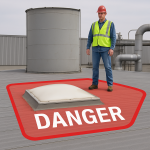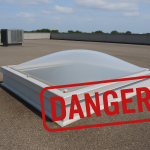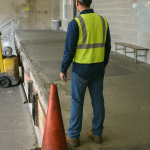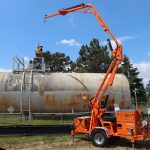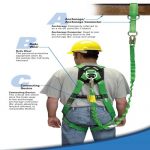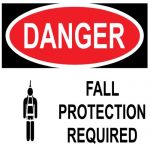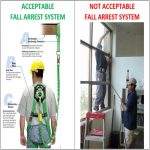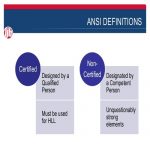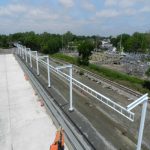OSHA Fall Hazard Blind Spots: Openings & Maintenance Access
The Hidden Hazards You Walk Past Every Day
Skylights, hatches, mezzanine pits. Tops of silos, tanks, or HVAC units. These areas don’t always look dangerous — until someone falls.
When it comes to fall protection in general industry, the two most overlooked categories are:
- Openings that aren’t always open
- Machinery maintenance access points
Both are common. Both are deadly. And both are called out clearly in OSHA and ANSI standards.
- Openings That Aren’t Always Open
Skylights, roof hatches, mezzanine drops, floor cutouts, and pit access points
These are deceptively dangerous areas. Whether they’re used once a month or once a day, any opening that a worker could fall through must be protected.
OSHA 29 CFR 1910.28(b)(3)(i)
“Each employee must be protected from falling through any hole (including skylights) that is 4 feet or more above a lower level by a cover or guardrail system.”
Even temporary cutouts or uncovered leveler pits during cleaning qualify under this standard.
Skylights Are NOT Safe to Stand On
They are considered holes in the walking-working surface per OSHA. If someone can fall through it, it must be protected.
Common Facility Risks:
- Roof hatches left open during inspections
- Floor holes cut during retrofits
- Dock leveler service openings
- Skylights mistaken for solid surfaces
- Mezzanine transfer zones with no guarding
- Machinery Maintenance Areas
Elevated or awkward areas where technicians access equipment for inspection, service, or repair
When workers climb on top of equipment — like silos, presses, ovens, or production lines — they’re often exposed to fall risks without dedicated anchor points, guardrails, or designated access platforms.
OSHA 29 CFR 1910.23(c)
“Each employee on a walking-working surface with an unprotected side or edge that is 4 feet or more above a lower level must be protected by guardrail systems, safety nets, or personal fall protection systems.”
ANSI Z359.2 & Z359.18
- Z359.2: Requires hazard assessments and formal procedures for elevated service tasks
- Z359.18: Specifies structural anchorage design and use requirements for fall arrest systems around equipment and machinery
Common Maintenance Hazards:
- Standing on top of industrial ovens, chillers, or presses
- Climbing above ducting or piping for access
- Walking on narrow steel beams or catwalks
- Reaching across conveyor belts or hoppers
How FallProof Fixes the Blind Spots
Our team specializes in designing and installing turnkey fall protection systems for the areas most often missed:
For Openings:
- Skylight safety screens (non-penetrating options available)
- Hatch rail systems with self-closing gates
- Custom floor hole covers that meet load rating standards
For Maintenance Access:
- Overhead rigid tracks for SRL systems
- Custom platforms with guardrails for safe access
- Permanent or portable anchor points for fall arrest
- Field assessments to pinpoint blind spots before they become incidents
📅 Schedule a facility walkthrough »
📞 Or speak directly with our safety engineering team at (609)-325-5555
Final Word
Openings and elevated maintenance zones don’t always get flagged as fall hazards — but they should.
They’re the places where workers take shortcuts, and where one slip can become a catastrophe.
Let’s make sure your facility isn’t one hazard away from a headline.

